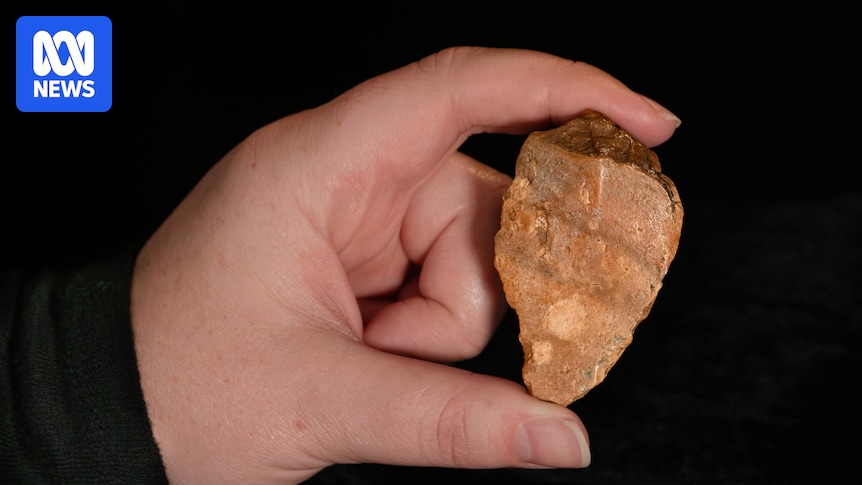Ancient humans lived on the Indonesian island of Sulawesi at least a million years ago — 800,000 years earlier than previously known — according to stone tools found under a corn field.
The artefacts, which were unveiled today in the journal Nature, may even be up to 1.48 million years old.
But exactly which ancient human species left the tools, or even how they managed to get there in the first place, is a mystery.
Griffith University archaeologist and study co-author Adam Brumm said the previous oldest evidence of humans in Sulawesi was 194,000-year-old stone tools, also found by his team.
“We’d always suspected that we would eventually find much older evidence for a human presence on the island,” Professor Brumm said.
“And now we finally have.”
Looking for million-year-old evidence
The tools were excavated from a site near the town of Soppeng, in southern Sulawesi.
Professor Brumm said Indonesian archaeologist Budianto Hakim, the study’s lead author, had long suspected the site would be a good spot to excavate because there were well-preserved fossils on the surface, suggesting more might be below.
From 2019 to 2022, the team found seven stone artefacts just 1.4 metres into the soil alongside an ancient pig fossil.
The stone tools had characteristic shapes researchers refer to as “flakes”. (Supplied: University of New England/MW Moore)
The tools were shaped in a way that suggested an intelligent craftsperson, Professor Brumm said.
“There’s no other type of creature that is able to reliably fracture stones by hitting them at the right angle and the exact amount of force required to induce that stone to fracture in a specific way,” he said.
“It’s some earlier form of human for sure, but it’s definitely a human intelligence producing these fractured stones.”
The dig was led by Budianto Hakim from the National Research and Innovation Agency of Indonesia (BRIN). (Supplied: BRIN)
The tools themselves could not be directly dated, but the researchers could calculate the age of the sediments and the pig fossil surrounding the tools.
They used two techniques: “palaeomagnetic dating”, which involves studying magnetic elements in sediments to see how they aligned with historic shifts in the Earth’s magnetic field, and “uranium-coupled electron spin resonance” dating, which looked at tiny amounts of uranium in the fossilised pig teeth.
These dating techniques suggested the tools were 1.04 to 1.48 million years old.
Ancient humans in South-East Asia
While this new discovery moves Sulawesi’s human habitation timeline way back, neighbouring islands have also yielded signs of human occupation from a similar period.
On Luzon, directly to the north of Sulawesi in the modern-day Philippines, archaeologists have found 700,000-year-old stone tools and 500,000-year-old bones from an ancient species dubbed Homo luzonensis.
Meanwhile Flores, directly to the south, is home to the famous Homo floresiensis, or “hobbit”.
The earliest evidence of Flores’ occupation dates back to 1.02 million years ago.
Tiny arm bone points to origins of the ‘hobbit’
At the same time, Java, to the west, was home to Homo erectus, an ancestor of modern humans that died out just over 100,000 years ago.
Given the surrounding islands’ evidence, Andy Herries, an archaeologist at La Trobe University who wasn’t involved in the new research, said the Sulawesi find was interesting but not unexpected.
But, he said, the presence of ancient humans on all of these islands raised a “curious question”: how did these early humans get there?
While Java was connected to the mainland at the time, thanks to lower sea levels during an ice age, Sulawesi and the other islands were still separated by deep water.
“We don’t think, a million years ago, that [early human species] had the technology to make boats,” Professor Herries said.
“It is something that I do muse about quite a bit.”
The dig took place under a corn field, near the site where 200,000-year-old tools had previously been found. (Supplied: BRIN)
Who left the tools behind?
One thing is certain: the find pre-dates the emergence of our own species, Homo sapiens, by at least 700,000 years.
This means the people who left these tools behind weren’t modern humans.
Without fossilised remains, such as bones and teeth, Professor Brumm said it was difficult to tell what sort of early human made the million-year-old Sulawesi tools.
“We suspect that they were the species Homo erectus,” he said.
“We suspect that these Homo erectus were somehow able to get across from the edge of mainland Asia, across the very significant water gap, to Sulawesi.”
The discovery also adds weight to the theory that hominids moved through the region from the northern Philippines to Flores in the south, rather than west to east from Java. (Supplied: Adam Brumm/Griffith University)
The toolmakers could also be a species that evolved from a Homo erectus population isolated on Sulawesi, like the hobbits of Flores.
Professor Herries agreed that Homo erectus was a possible candidate, but given there wasn’t direct fossil evidence, it could also easily be something else.
Finding elusive fossils on Sulawesi, according to Professor Brumm, would be the team’s “dream discovery”.
“These new stone tools from Sulawesi are another important piece of the puzzle, but there are many more pieces that remain undiscovered,” he said.
“We’ve just got to keep digging.”

